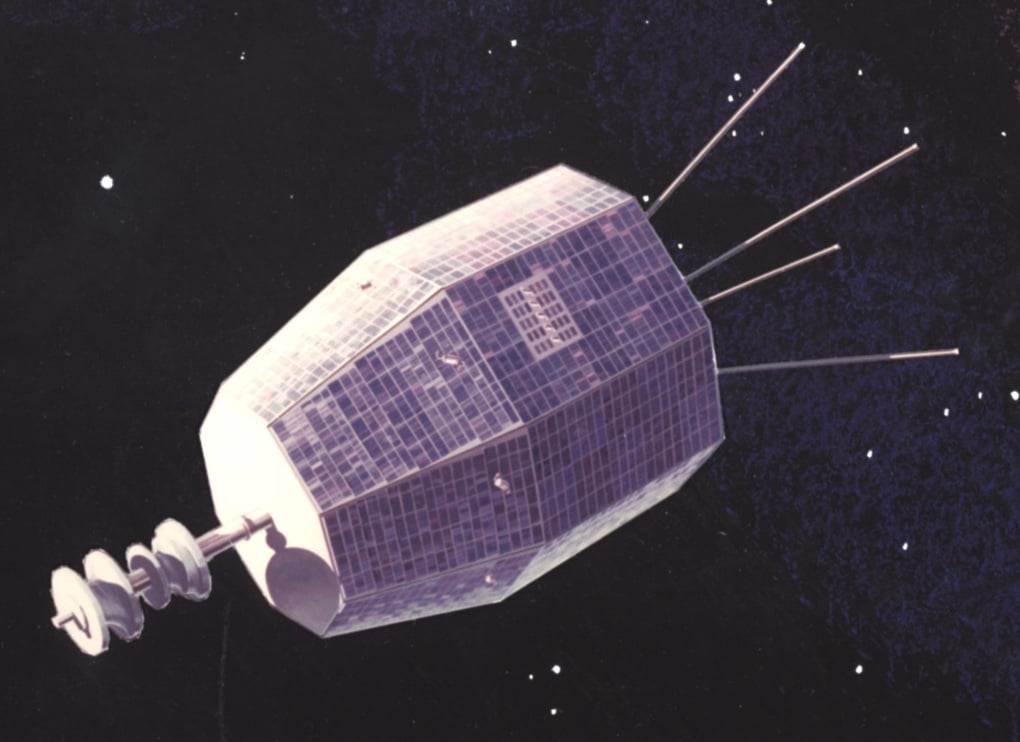An extremely powerful radio signal, lasting less than 30 nanoseconds, suddenly appeared in the sky over Western Australia on June 13, 2024, surprising scientists at a local observatory.
Initially, the origin of this signal pulse was a big mystery, thought to come from the depths of the universe. However, after in-depth data analysis, researchers discovered a surprising truth: this signal did not come from a distant celestial body, but from Relay-2, a NASA satellite that stopped working 57 years ago.
Illustration of Relay-2 satellite in space (Photo: NASA).
Relay-2, launched into orbit by the National Aeronautics and Space Administration (NASA) on January 21, 1964, was one of two pioneering telecommunications satellites.
Its missions include transmitting television signals and collecting data on the Allen radiation belt, contributing significantly to the study of the near-Earth space environment.
The satellite ceased operations on June 9, 1967, after two of its transmitters failed, cutting off all communication with Earth. From then on, Relay-2 was considered “dead” until a brief event in mid-June.
Mr. Clancy James, a space researcher at Curtin University, Australia, could not hide his initial excitement: "We were very excited, thinking that we had received a signal from some new object in the universe.
This is an incredibly powerful radio burst that outstrips everything else in the sky, even for a very short period of time." Fast Radio Bursts (FRBs) are powerful and short-lived radio bursts that often originate from deep space, releasing huge amounts of energy in just a few milliseconds.
It is worth noting that at the time the signal was detected, the Relay-2 satellite was flying directly above the Western Australian Radio Astronomy Observatory.
The reason behind the unexpected "resurrection" of Relay-2 after nearly six decades remains a big question for scientists.
One theory is that the satellite accumulated a large amount of static electricity over years of drifting in space and suddenly discharged it in a powerful burst of energy.
Another possibility is that Relay-2 collided with micrometeorites – small particles of dust or debris in orbit – causing the release of a plasma cloud, which in turn emitted a signal recorded on Earth.
Although this is not the first time that "dead" or missing satellites have suddenly reappeared, the return of Relay-2 after nearly 6 decades still baffles scientists.
In the past, some satellites have been able to drift out of orbit and then right themselves, or accumulate enough energy from their solar batteries after a long period of exhaustion to transmit signals. However, the case of Relay-2 is extremely rare and has no satisfactory explanation.
The growing number of defunct satellites floating around Earth, sometimes still emitting signals, is posing a major challenge for scientists in distinguishing between "echoes" from old machines and genuine messages from the distant universe.
Source: https://dantri.com.vn/khoa-hoc/ve-tinh-nasa-da-chet-57-nam-truoc-bat-ngo-gui-tin-hieu-bi-an-ve-trai-dat-20250625023652499.htm




![[Photo] Panorama of the cable-stayed bridge, the final bottleneck of the Ben Luc-Long Thanh expressway](https://vphoto.vietnam.vn/thumb/1200x675/vietnam/resource/IMAGE/2025/9/30/391fdf21025541d6b2f092e49a17243f)
![[Photo] President Luong Cuong receives President of the Cuban National Assembly Esteban Lazo Hernandez](https://vphoto.vietnam.vn/thumb/1200x675/vietnam/resource/IMAGE/2025/9/30/4d38932911c24f6ea1936252bd5427fa)
![[Photo] General Secretary To Lam, Secretary of the Central Military Commission attends the 12th Party Congress of the Army](https://vphoto.vietnam.vn/thumb/1200x675/vietnam/resource/IMAGE/2025/9/30/9b63aaa37ddb472ead84e3870a8ae825)
![[Photo] The 1st Congress of Phu Tho Provincial Party Committee, term 2025-2030](https://vphoto.vietnam.vn/thumb/1200x675/vietnam/resource/IMAGE/2025/9/30/1507da06216649bba8a1ce6251816820)
![[Photo] Solemn opening of the 12th Military Party Congress for the 2025-2030 term](https://vphoto.vietnam.vn/thumb/1200x675/vietnam/resource/IMAGE/2025/9/30/2cd383b3130d41a1a4b5ace0d5eb989d)

































































































Comment (0)